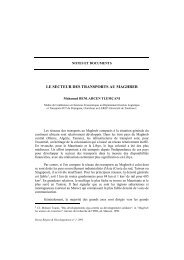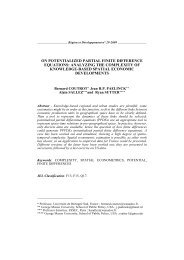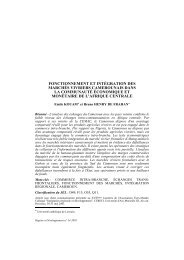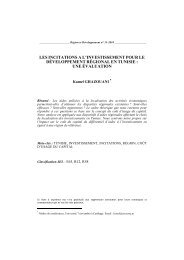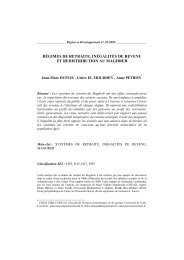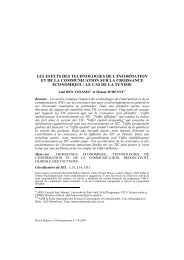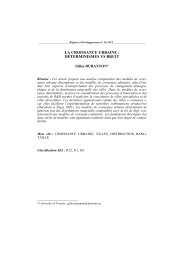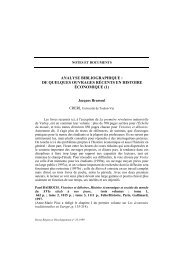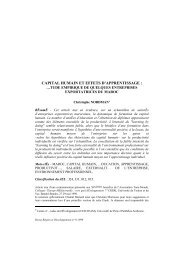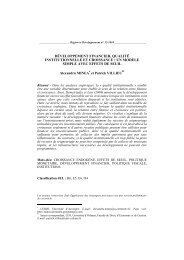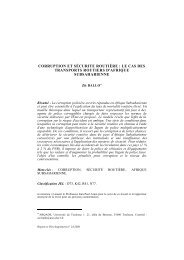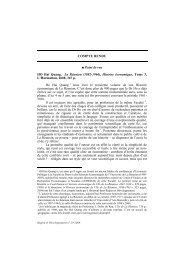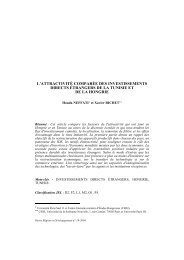space and growth: a survey of empirical evidence ... - ResearchGate
space and growth: a survey of empirical evidence ... - ResearchGate
space and growth: a survey of empirical evidence ... - ResearchGate
Create successful ePaper yourself
Turn your PDF publications into a flip-book with our unique Google optimized e-Paper software.
16 Maria Abreu, Henri L.F. de Groot <strong>and</strong> Raymond J.G.M. Floraxomission <strong>of</strong> variables with a spatial dimension such as climate, latitude <strong>and</strong>topology. Moreover, the spatial econometrics literature might gain from delvingmore deeply into the policy <strong>and</strong> theoretical implications <strong>of</strong> their results. On theother h<strong>and</strong>, the non-spatial econometrics literature would do well to adopt themore rigorous approach to testing, modeling <strong>and</strong> visualization <strong>of</strong> the resultsdeveloped in spatial econometrics. The residuals <strong>of</strong> mainstream models shouldbe tested for spatial dependence, since ignoring it could result in serious modelmisspecification.The rest <strong>of</strong> our article is organized as follows. In Section 2, we review thetreatment <strong>of</strong> <strong>space</strong> in the non-spatial econometric <strong>and</strong> the spatial econometricliteratures, <strong>and</strong> discuss the distinction between models <strong>of</strong> absolute <strong>and</strong> relativelocation. In Section 3, we discuss several unresolved issues in the application <strong>of</strong>spatial econometrics to the study <strong>of</strong> economic <strong>growth</strong>. In Section 4, we discussdirections for further research <strong>and</strong> conclude.2. AN OVERVIEW OF THE LITERATUREThis section provides a global overview <strong>of</strong> the <strong>empirical</strong> literature that hasinvestigated the role <strong>of</strong> <strong>space</strong> in explaining variation in economic <strong>growth</strong>. Inorder to facilitate the discussion, we divide the literature into studies thatexplicitly apply spatial econometric techniques <strong>and</strong> those that do not. The formerare predominantly concerned with relative location, while the latter focus onabsolute location. A more detailed classification with brief descriptions <strong>and</strong>examples can be found in Table 1.2.1. Space in the non-spatial econometrics literatureThe non-spatial econometrics literature has largely focused on models <strong>of</strong>absolute location, <strong>and</strong> the studies therefore (implicitly) focus on spatialheterogeneity. The notion <strong>of</strong> spatial heterogeneity that we consider here isbroader than the one typically used in the spatial econometrics literature, whichis tightly linked to the concept <strong>of</strong> spatial regimes1.In models that apply spatial regimes, the parameters are allowed to varyacross groups <strong>of</strong> countries or regions (the regimes), <strong>and</strong> <strong>of</strong>tentimes groupwiseheteroscedasticity is also allowed. Our argument is that while spatial regimes isan extreme form <strong>of</strong> spatial heterogeneity, incorporating spatial variables directlyinto the regression also takes account <strong>of</strong> spatial heterogeneity, albeit on a moregradual <strong>and</strong> refined scale.1 By spatial regimes we mean models in which the sample is divided into groups according to thevalues taken by a variable with a spatial dimension, for example North <strong>and</strong> South (according tolatitude), or tropical, subtropical <strong>and</strong> temperate (according to climate zone).




